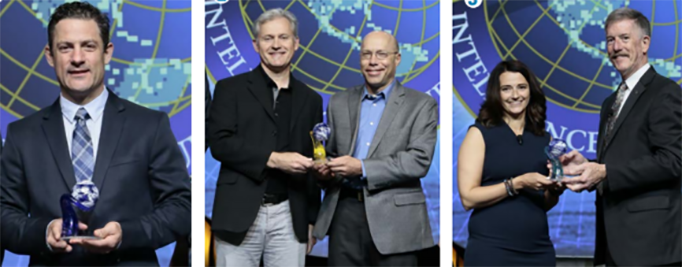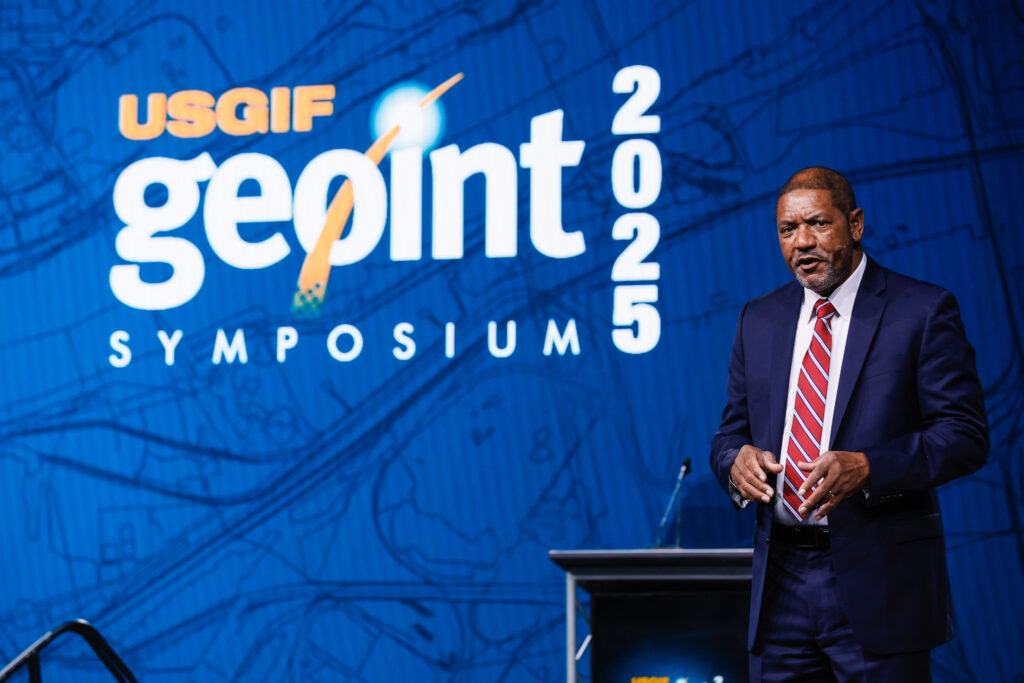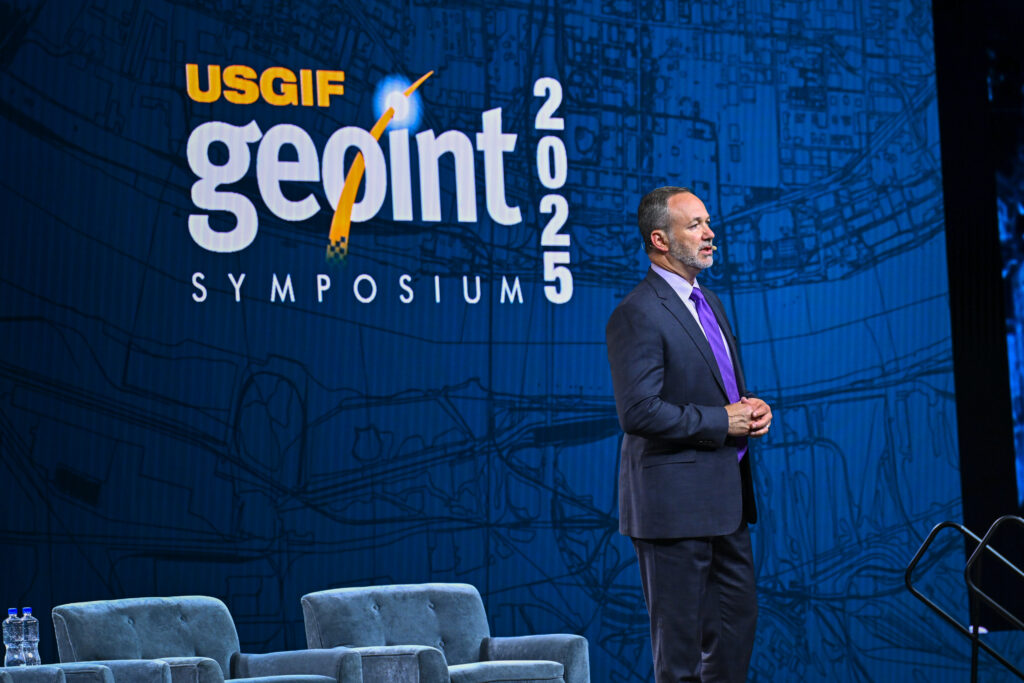USGIF Announces 2019 Achievement Award Winners
The USGIF Awards Program annually recognizes the exceptional work of the geospatial intelligence tradecraft’s brightest minds and organizations pushing the community forward. Award winners are nominated by their colleagues and selected by the USGIF Awards Subcommittee.

USGIF Announces 2019 Achievement: USGIF announced this week the 2019 recipients of its annual Awards Program. Award winners were recognized on the main stage at the Foundation’s GEOINT 2019 Symposium, taking place June 2-5 in San Antonio, Texas.
The USGIF Awards Program annually recognizes the exceptional work of the geospatial intelligence tradecraft’s brightest minds and organizations pushing the community forward. Award winners are nominated by their colleagues and selected by the USGIF Awards Subcommittee.
“GEOINT is about how we see the world and how we predict, plan, respond, and react to the world’s greatest challenges and opportunities,” said Kevin Jackson, chair of the USGIF Awards Subcommittee. “This year brought us some very exciting and unique nominations and tradecraft applications that truly demonstrate how GEOINT has expanded into new domains. We are excited about the 2019 award winners and what’s in store for the future of GEOINT.”
The 2019 USGIF Award winners are:
ACADEMIC
Aaron Gerace and Matthew Montanaro, Rochester Institute of Technology
Shortly after launch, on-orbit commissioning procedures indicated that TIRS-1, Landsat 8’s thermal instrument, had a stray-light issue. To identify the sources of stray-light, NASA’s Goddard Space Flight Center performed several slew maneuvers, moving the moon in and out of the TIRS-1 field of view. These data were leveraged to develop a per-detector optical model. Aaron Gerace and Matthew Montanaro of RIT developed an approach that uses the data at the edge of a TIRS-1 swath, in conjunction with the optical model, to estimate the incident out-of-field radiance and in turn mitigate stray-light effects. As a result, errors were significantly reduced.
INDUSTRY
Jeffrey D. Clark, Ph.D., Riverside Research
Dr. Jeffrey Clark, supporting the U.S. Air Force in collaboration with the National Geospatial-Intelligence Agency, led extensive efforts to integrate machine learning and AI into mainstream GEOINT data processing. Dr. Clark pioneered mission integration and propagated the tradecraft and application methods throughout the Intelligence Community. His prototype algorithms drove the design and integration of artificial neural networks into overhead persistent infrared (OPIR) production processes, revolutionizing the OPIR processing chain across phases and centers. Dr. Clark’s technical leadership and tradecraft advocacy improved analytical efficiencies and predictive intelligence, ensuring the nation is at the forefront of understanding threats to U.S. air and space operations.
GOVERNMENT
Rachael Brady, CAL FIRE
As a research data specialist with the California Department of Forestry and Fire Protection (CAL FIRE), Rachael Brady worked diligently to create a statistical methodology and employs geospatial analysis to identify serial wildland arson patterns. Her work has allowed for earlier detection of potential arson series throughout Northern California. Every ignition has the potential to become a devastating fire in California’s dry vegetation, and early detection of a potential serial arsonist allows CAL FIRE to respond in a timely manner, increasing the chances of capturing a suspect and preventing a catastrophic fire.
MILITARY
GUARDIAN Team, National Guard Bureau
The GUARDIAN Team includes Texas Air National Guardsmen Maj. Alexander Goldberg, Maj. Curtis Wilson, Maj. Michael McDermott, and Maj. Travis Williams. The team created a web-based, next-generation, multi-domain command and control geospatial application called GUARDIAN. The application is built upon a modular, non-proprietary, open architecture that enables agile development. GUARDIAN provides real-time decision-making and two-way collaboration among the tactical, operational, and strategic command echelons. Within the last year, GUARDIAN has been adopted by more than 250 federal, state, and local agencies for both combat operations and in support of civilian emergency response efforts.
COMMUNITY SUPPORT
Taking Autism To The Sky, Inc.
Taking Autism To The Sky (TATTS) is a volunteer run, 501©(3) nonprofit organization that uses unmanned aerial vehicles (drones) to help autistic individuals practice and develop social and employment skills. TATTS began as a crowd-funded project in 2012 and has grown to include image analysis, teamwork, and data processing skills that are in high demand by the geospatial industry. Autistic individuals often struggle with understanding other people’s points of views, yet their literal and visual thinking skills are an asset to the geospatial industry. TATTS helps these individuals see their world from a new perspective.
Learn more about the USGIF Awards Program and past award recipients.
Related Articles
GEOINT Symposium 2025 Day Two Recap
Forging the Future of GEOINT: Interoperability, AI, and Global Collaboration Take Center Stage The second day of the 2025 GEOINT Symposium highlighted evolvin…
GEOINT Symposium 2025 Day One Recap
Innovation, Integration, and Global Security The critical intersection of innovation, collaboration, and capacity building to address the evolving challenges o…
GEOINT Foreword 2025 Recap
Emerging Tech, Ethical Innovation, and the Future of Geospatial Intelligence On Sunday, May 18, over 500 participants gathered for GEOINT Foreword 2025. This ev…




